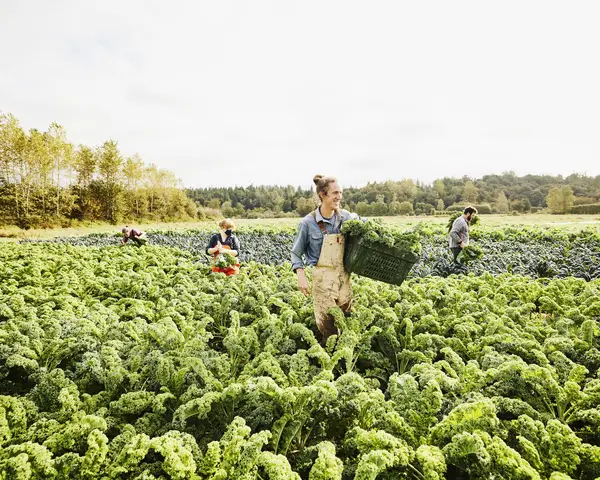Informing decision-making in the food and agriculture sectors to benefit health, the economy, and the environment
The food system has far reaching effects on human health, the economy, and the environment. Policies and initiatives to improve the functioning of the food system can substantially benefit society. We conduct analyses using a broad range of analysis tools to understand the effects and evaluate options to improve nutrition, food safety, and food labeling and to reduce food waste and the impacts of climate change, among other topics. We develop economic and cost models; conduct cost-effectiveness and benefit-cost analyses; conduct consumer preference studies; conduct process, outcome, and impact evaluations; analyze store and household scanner data; and develop data products and documentation. We work collaboratively with our clients to develop tools and information to support decision-making and prioritization for regulations, programs, policies, and voluntary initiatives.

Examining the Effects of Taxes and Warning Labels on Parents' Purchases of Sugar-Sweetened Beverages Using a Choice Experiment
Evidence suggests that sugar sweetened beverage consumption is positively associated with or influences whether children have obesity. To assess the combined effectiveness of including both taxes and warning labels on sugar-sweetened beverages to reduce parent’s purchases, RTI is conducting a discrete choice experiment with funding from Robert Wood Johnson Foundation’s Healthy Eating Research Program. The study will examine the impact of these initiatives across low- and high-income, Black, Latinx, and White parents.

Assessing the Public Health Impacts of the Children's Food and Beverage Advertising Initiative
The Children’s Food and Beverage Advertising Initiative (CFBAI) is a voluntary industry initiative in which companies commit to feature only foods meeting specific nutrition criteria in advertising directed primarily to children under age 12. RTI linked household-based scanner data with nutrition label data to determine the extent to which U.S. households with children from 0 to 8 years purchase CFBAI-listed foods and to simulate the potential effects of reformulation because of changes to the nutrition criteria. The results of this study indicate the need to ensure that the design of voluntary industry initiatives will result in a positive public health impact.

Evaluation Technical Assistance
Efforts in the United States and abroad to address the chronic disease epidemic have led to the emergence of voluntary industry agreements as a substitute for regulatory approaches to improve the healthfulness of foods and beverages. Under a grant with RWJF, we provided technical assistance for evaluation of voluntary industry initiatives including developing approaches, developing logic models, documenting the industry and policy context, understanding consumer responses, and identifying methods and metrics to evaluate impacts on the availability, consumption, and pricing of healthier foods and beverages.

Foreign Agricultural Service (FAS) Trade Model
FAS actively develops U.S. agricultural trade initiatives to respond to foreign trade barriers thereby advancing a transparent, predictable, and stable global trading environment for U.S. farmers and ranchers. RTI developed an Excel-based model of over 700 products to allow USDA to quickly estimate the economic impacts of new trade policies and regulatory measures. The model allows users to analyze the effects of tariff and nontariff trade barriers on trade flows, prices, and consumer and producer surplus based on a partial-equilibrium modeling approach.

Developing Measures of the Food Price Environment
The USDA Economic Research Service (ERS) uses proprietary household-based and store-based scanner data to develop high-profile data products that are widely used by the agency and academic researchers to address research questions relevant to USDA’s mission. To support ERS’s efforts, RTI assessed the quality of the data and is developing store-level weights for stores in the store-based scanner data, developing a mapping between product codes and the ERS Food Purchase Groups, and creating the Food-at-Home Monthly Area Prices (F-MAP) database. The resulting data products will enhance the ability of researchers to use scanner data and better understand the effects of food prices on consumer behavior and policy outcomes. As part of this effort, RTI also organized and conducted a 2-day workshop for researchers using scanner data to discuss the characteristics of the data and their application to food economics research.

Modernizing Safe Handling and Ready-to-Eat/Not-Ready-to-Eat Labeling
The USDA, Food Safety and Inspection Service (FSIS) has received requests and petitions to update the Safe Handling Instructions (SHI) label that is required on all raw and partially cooked meat and poultry products. To provide FSIS with information to inform decisions about potentially modernizing the SHI, we conducted a multi-phase study. First, we conducted a web-based experiment with a sample of U.S. consumers to select three variants of a revised SHI label (among 27 variants) that best attract participants’ attention. We then conducted a study in test kitchens using a randomized experimental design in which participants prepared a meal while wearing an eye-tracking device to evaluate the visual salience and effectiveness of the three revised SHI labels versus the current SHI label on adherence to recommended safe handling instructions. Information on consumer handling practices from the test kitchen study were used in a predictive model to estimate reductions in foodborne illness as a result of a revised SHI label. We then conducted a cost-benefit analysis of revising the SHI label using results from the predictive modeling, foodborne illness cost-of-illness estimates, and estimates of industry compliance costs.

Analyzing Consumers’ Value of “Product of USA” Labeling Claims
The USDA, Food Safety and Inspection Service (FSIS) has received complaints and petitions that suggest that the “Product of USA” labeling claim may not accurately reflect consumer understanding about the origin of FSIS-regulated meat products. To address this concern, FSIS intends to initiate rulemaking after conducting a comprehensive review of the current voluntary “Product of USA” label. To help inform FSIS’s rulemaking, RTI is conducting a nationally representative web-based survey and experiment to provide information on consumer awareness, understanding, and willingness to pay for the current “Product of USA” label and potential revised definitions. The survey will use a limited-time exposure experiment to assess consumer awareness and a discrete choice experiment to measure consumer willingness-to-pay.

Expert Panel to Estimate the Costs of Food Safety Investments
USDA’s Food Safety and Inspection Service required data on the costs for meat and poultry plants to implement food safety measures to help inform analyses of its policies. Using an expert panel process, RTI developed estimates of costs of capital equipment, labor, materials, and other costs associated with food safety investments made by meat and poultry slaughter and processing establishments under FSIS’s jurisdiction. Estimates were developed by establishment size and type for developing food safety plans, conducting food safety training, operating antimicrobial equipment, conducting third-party audits, and conducting pathogen testing.

Food Environment Analysis to Inform Consumer-Driven Food Market System Programming for Better Maternal and Child Nutrition
RTI developed a toolkit that identifies drivers of food choice for nutritious foods in vulnerable households and collects data on food market systems for nutritious foods. The information on personal and market factors influencing food purchasing and consumption is used to develop actionable recommendations that market actors can take to increase access to, and subsequently consumption of, nutritious foods by mothers and young children. The toolkit was developed in Malawi and has been used in USAID-funded programs in Ethiopia and Liberia.

Promoting Agricultural Resilience and Enhancing Food Security: Building Decision-Support Tools to Advance Sustainable and Cost-Effective Strategies
Governments, civil society, farmers, and other stakeholders need to make data-driven, evidence-based decisions regarding agricultural production, development priorities, and policies to enhance food security, resilience, and sustainability of the agricultural sector. However, in many regions, existing data are incomplete, inconsistent, located within disparate sources, may not be spatially disaggregated, and cannot readily be used to inform integrated decision-making. RTI conducted a study utilizing geospatial data, including remote sensing imagery collected using unmanned aerial vehicles and satellites, combined with statistical and machine learning models to conduct multiple analyses of the agricultural system. These included assessment of the timing of planting, identification of major crops and estimation of area planted by crop, monitoring of crop conduction during the growing season, effects of management practices on farmer revenue, and estimation of climate change impacts on future crop productivity.

Assessing the Impacts of Elevated Atmospheric Carbon Dioxide on Global Nutrient Availability
Climate change can impact not only the quantity of food produced but also the quality of that food. In addition to effects on agricultural productivity, elevated levels of atmospheric carbon dioxide reduce the nutrient content of many crops. As carbon dioxide levels rise, the edible portions of plants tend to have higher proportions of carbon (and thus carbohydrates) and lower proportions of most other macronutrients (e.g., protein) and micronutrients (e.g., iron, potassium, zinc). RTI led a study in collaboration with EPA, USDA, and other research partners to assess the combined effects of changes in productivity and nutrient content on global nutrient availability per capita at the country level under climate change scenarios.

Food Systems Modeling
RTI’s food system capabilities include infrastructure assessments, food systems-driven economic development evaluation, agent-based modeling, price analysis (including time-series and Granger causality analyses), optimization modeling, supply chain mapping and margining, and hedonic price analysis. Our recent project experience includes modeling supply chains and institutional food procurement. We provided data analysis and modeling support for a Colorado State University food system agent-based modeling project that examined the impacts of urban food policy in the city of Denver, Colorado on the rural areas in the state. A new effort is now underway to apply similar modeling techniques to understand the impacts of policies implemented by the second-largest institutional procurer of food in the country, the City of New York. Optimization modeling is another approach that can be used to understand decision-making of institutions procuring food.

Assessing the Effectiveness of Oregon’s Farm‐to‐School Program in Providing Locally Grown, Nutritious Foods to Low‐Income, Minority Students
RTI assessed the effectiveness and reach of expanded Farm to School legislation in Oregon aimed at increasing farm-to-school activities in Oregon schools through higher reimbursements for local food purchases and a larger competitive school garden grant program. The study conducted key informant interviews and estimated the reach, adoption, and implementation of the program on low-income schools using extant data. RTI identified Oregon’s farm to school state policy design attributes that have successfully leveraged limited state resources to improve farm-to-school participation among school districts.

Opportunities for AgriFood Tech in Western North Carolina
The Opportunities for AgriFood Tech in Western North Carolina project explored innovative ways the region can fuel economic growth in agriculture and food technology (AgriFood Tech). The project outlined new pathways for economic opportunity and wealth building, particularly for the rural areas of Western North Carolina. The assessment brought forward two key perspectives: AgriFood Tech for new business growth and AgriFood Tech for on-farm and value-chain gains. Three key opportunities were identified:
1) Promoting on-farm climate resiliency to prepare farmers to thrive amidst uncertainty, thus offering a path to on-farm prosperity and rural wealth creation
2) Diversifying and growing WNC as a recognized leader in natural and other value-added products to build high-quality jobs in food value addition in alignment with the region’s broader nature-based economy
3) Catalyzing WNC as a luminary of circular economic development, anchoring in closed-loop AgriFood and textile sectors.
Related Projects
The Impact of Food Reformulation on Child and Adolescent Diet Quality
Read More about The Impact of Food Reformulation on Child and Adolescent Diet Quality















